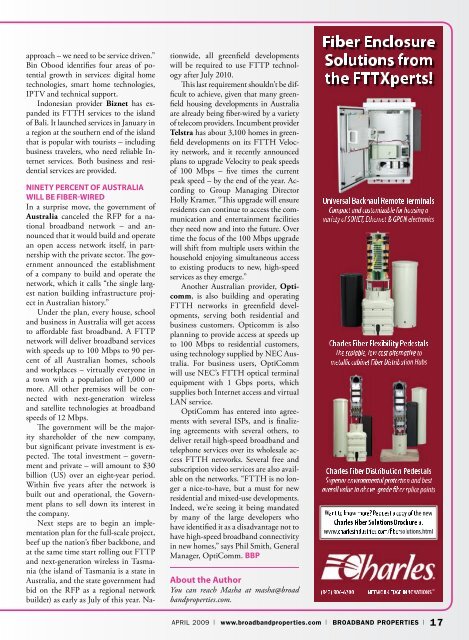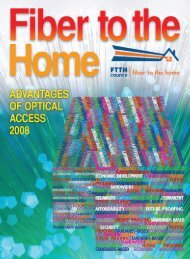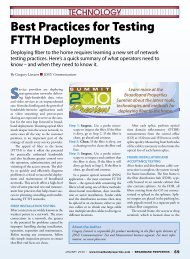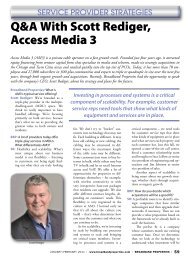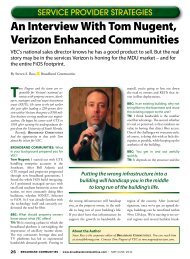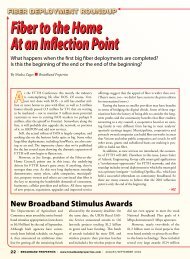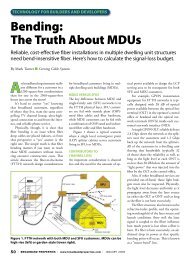Download - Broadband Properties
Download - Broadband Properties
Download - Broadband Properties
Create successful ePaper yourself
Turn your PDF publications into a flip-book with our unique Google optimized e-Paper software.
approach – we need to be service driven.”<br />
Bin Obood identifies four areas of potential<br />
growth in services: digital home<br />
technologies, smart home technologies,<br />
IPTV and technical support.<br />
Indonesian provider Biznet has expanded<br />
its FTTH services to the island<br />
of Bali. It launched services in January in<br />
a region at the southern end of the island<br />
that is popular with tourists – including<br />
business travelers, who need reliable Internet<br />
services. Both business and residential<br />
services are provided.<br />
Ninety Percent of Australia<br />
Will Be Fiber-Wired<br />
In a surprise move, the government of<br />
Australia canceled the RFP for a national<br />
broadband network – and announced<br />
that it would build and operate<br />
an open access network itself, in partnership<br />
with the private sector. The government<br />
announced the establishment<br />
of a company to build and operate the<br />
network, which it calls “the single largest<br />
nation building infrastructure project<br />
in Australian history.”<br />
Under the plan, every house, school<br />
and business in Australia will get access<br />
to affordable fast broadband. A FTTP<br />
network will deliver broadband services<br />
with speeds up to 100 Mbps to 90 percent<br />
of all Australian homes, schools<br />
and workplaces – virtually everyone in<br />
a town with a population of 1,000 or<br />
more. All other premises will be connected<br />
with next-generation wireless<br />
and satellite technologies at broadband<br />
speeds of 12 Mbps.<br />
The government will be the majority<br />
shareholder of the new company,<br />
but significant private investment is expected.<br />
The total investment – government<br />
and private – will amount to $30<br />
billion (US) over an eight-year period.<br />
Within five years after the network is<br />
built out and operational, the Government<br />
plans to sell down its interest in<br />
the company.<br />
Next steps are to begin an implementation<br />
plan for the full-scale project,<br />
beef up the nation’s fiber backbone, and<br />
at the same time start rolling out FTTP<br />
and next-generation wireless in Tasmania<br />
(the island of Tasmania is a state in<br />
Australia, and the state government had<br />
bid on the RFP as a regional network<br />
builder) as early as July of this year. Nationwide,<br />
all greenfield developments<br />
will be required to use FTTP technology<br />
after July 2010.<br />
This last requirement shouldn’t be difficult<br />
to achieve, given that many greenfield<br />
housing developments in Australia<br />
are already being fiber-wired by a variety<br />
of telecom providers. Incumbent provider<br />
Telstra has about 3,100 homes in greenfield<br />
developments on its FTTH Velocity<br />
network, and it recently announced<br />
plans to upgrade Velocity to peak speeds<br />
of 100 Mbps – five times the current<br />
peak speed – by the end of the year. According<br />
to Group Managing Director<br />
Holly Kramer, “This upgrade will ensure<br />
residents can continue to access the communication<br />
and entertainment facilities<br />
they need now and into the future. Over<br />
time the focus of the 100 Mbps upgrade<br />
will shift from multiple users within the<br />
household enjoying simultaneous access<br />
to existing products to new, high-speed<br />
services as they emerge.”<br />
Another Australian provider, Opticomm,<br />
is also building and operating<br />
FTTH networks in greenfield developments,<br />
serving both residential and<br />
business customers. Opticomm is also<br />
planning to provide access at speeds up<br />
to 100 Mbps to residential customers,<br />
using technology supplied by NEC Australia.<br />
For business users, OptiComm<br />
will use NEC’s FTTH optical terminal<br />
equipment with 1 Gbps ports, which<br />
supplies both Internet access and virtual<br />
LAN service.<br />
OptiComm has entered into agreements<br />
with several ISPs, and is finalizing<br />
agreements with several others, to<br />
deliver retail high-speed broadband and<br />
telephone services over its wholesale access<br />
FTTH networks. Several free and<br />
subscription video services are also available<br />
on the networks. “FTTH is no longer<br />
a nice-to-have, but a must for new<br />
residential and mixed-use developments.<br />
Indeed, we’re seeing it being mandated<br />
by many of the large developers who<br />
have identified it as a disadvantage not to<br />
have high-speed broadband connectivity<br />
in new homes,” says Phil Smith, General<br />
Manager, OptiComm. BBP<br />
About the Author<br />
You can reach Masha at masha@broad<br />
bandproperties.com.<br />
April 2009 | www.broadbandproperties.com | BROADBAND PROPERTIES | 17


